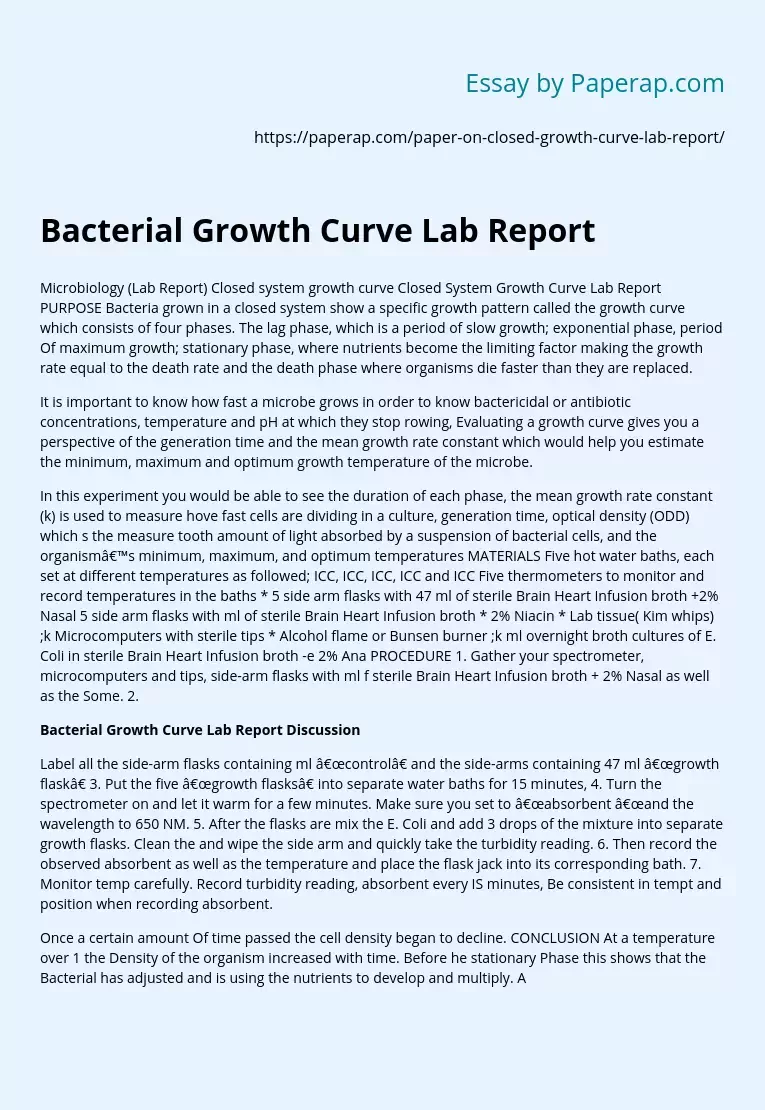Bacterial Growth Curve Lab Report
Microbiology (Lab Report) Closed system growth curve Closed System Growth Curve Lab Report PURPOSE Bacteria grown in a closed system show a specific growth pattern called the growth curve which consists of four phases. The lag phase, which is a period of slow growth; exponential phase, period Of maximum growth; stationary phase, where nutrients become the limiting factor making the growth rate equal to the death rate and the death phase where organisms die faster than they are replaced.
It is important to know how fast a microbe grows in order to know bactericidal or antibiotic concentrations, temperature and pH at which they stop rowing, Evaluating a growth curve gives you a perspective of the generation time and the mean growth rate constant which would help you estimate the minimum, maximum and optimum growth temperature of the microbe.
In this experiment you would be able to see the duration of each phase, the mean growth rate constant (k) is used to measure hove fast cells are dividing in a culture, generation time, optical density (ODD) which s the measure tooth amount of light absorbed by a suspension of bacterial cells, and the organism’s minimum, maximum, and optimum temperatures MATERIALS Five hot water baths, each set at different temperatures as followed; ICC, ICC, ICC, ICC and ICC Five thermometers to monitor and record temperatures in the baths * 5 side arm flasks with 47 ml of sterile Brain Heart Infusion broth +2% Nasal 5 side arm flasks with ml of sterile Brain Heart Infusion broth * 2% Niacin * Lab tissue( Kim whips) ;k Microcomputers with sterile tips * Alcohol flame or Bunsen burner ;k ml overnight broth cultures of E.
Coli in sterile Brain Heart Infusion broth -e 2% Ana PROCEDURE 1. Gather your spectrometer, microcomputers and tips, side-arm flasks with ml f sterile Brain Heart Infusion broth + 2% Nasal as well as the Some. 2.
Bacterial Growth Curve Lab Report Discussion
Label all the side-arm flasks containing ml “control” and the side-arms containing 47 ml “growth flask” 3. Put the five “growth flasks” into separate water baths for 15 minutes, 4. Turn the spectrometer on and let it warm for a few minutes. Make sure you set to “absorbent “and the wavelength to 650 NM. 5. After the flasks are mix the E. Coli and add 3 drops of the mixture into separate growth flasks. Clean the and wipe the side arm and quickly take the turbidity reading. 6. Then record the observed absorbent as well as the temperature and place the flask jack into its corresponding bath. 7. Monitor temp carefully. Record turbidity reading, absorbent every IS minutes, Be consistent in tempt and position when recording absorbent.
Once a certain amount Of time passed the cell density began to decline. CONCLUSION At a temperature over 1 the Density of the organism increased with time. Before he stationary Phase this shows that the Bacterial has adjusted and is using the nutrients to develop and multiply. As cell density increases so does the amount of variable cells. The tuft graphs differ because with time cell growth continues to increases. The graph of time and Original Density (ODD) differed in pattern than that in the graph of time and variable cells. This graph explains more of what goes on in a closed system and is more intricate in displaying it, In the lag phase the cells are adjusting to the new environment and medium.
Bacterial Growth Curve Lab Report. (2019, Dec 05). Retrieved from https://paperap.com/paper-on-closed-growth-curve-lab-report/

